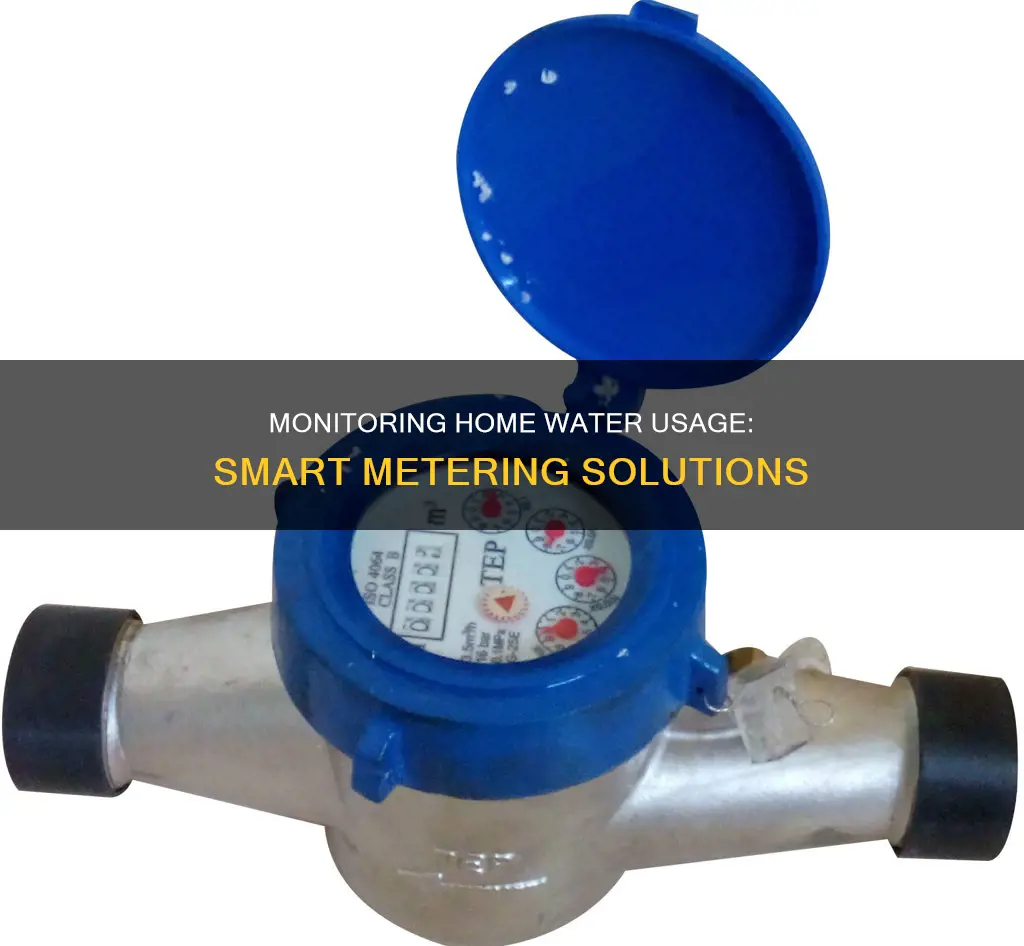
Monitoring water usage at home is important for several reasons. Firstly, it raises awareness of how water is used, enabling homeowners to identify ways to reduce consumption and waste. This not only helps the environment but also leads to lower utility expenses. Additionally, tracking water usage provides valuable insights about the plumbing system, helping to detect leaks and plan for upgrades. While some leaks are obvious, like a flooded basement, others are hidden and can cause significant water waste and damage over time. By monitoring water usage, homeowners can catch these issues early and prevent costly repairs. Furthermore, older appliances and fixtures often consume more water, and tracking usage can help identify opportunities to improve efficiency and save money. Water monitoring products, such as Flume 2, StreamLabs Monitor, and Flo by Moen, offer whole-home solutions or fixture-specific tracking, providing data on water consumption and leak detection. These products empower homeowners to make informed decisions about their water usage and take action to conserve this precious resource.
| Characteristics | Values |
|---|---|
| Purpose | To reduce water waste, lower utility bills, and protect your home from water damage |
| Benefits | Improve conservation efforts, improve your plumbing system, lower utility expenses |
| Usage Estimation | Use monthly utility bill readings to assess consumption |
| Water Monitoring Products | Water monitors, whole-home solutions with automatic shutoff valves and water sensors |
| Installation | No pipe cutting, no wiring, no appointments |
| Data Accessibility | Data delivered straight to an app |
What You'll Learn

Detect plumbing leaks
Detecting plumbing leaks early is crucial to prevent water damage and unnecessary costs. Here are some detailed methods to detect plumbing leaks in your home:
Check Your Water Meter
One of the best ways to determine if you have a leak is by monitoring your water meter. Ensure all water sources in your home, both indoors and outdoors, are turned off. Observe the water meter; if the dial is moving, it indicates water flow, suggesting a potential leak. For confirmation, wait a couple of hours and take another reading. If the meter reading has changed significantly, it confirms a leak.
Monitor Your Water Bill
A sudden, unexplained increase in your water bill could indicate a leak. Compare your current bill to previous months' bills to identify any unusual spikes in water consumption. A higher bill without a clear reason, such as an additional person in the household or increased gardening, may indicate a hidden leak.
Inspect Your Toilet
Toilets are common culprits of plumbing leaks. To detect a leak, add a few drops of food colouring to the tank above the toilet. Do not flush. If the coloured water appears in the toilet bowl within 30 minutes, your toilet is leaking. Also, inspect the ceiling below the toilet for staining or wet spots, which could indicate a leak.
Check Exterior Faucets and Irrigation Systems
Leaking faucets and irrigation systems can cause water wastage. Connect a garden hose to exterior faucets and check for water seepage at the connection. If leakage occurs, replace the rubber gasket and tighten the connection. Additionally, have a professional inspect your irrigation system annually to prevent and identify potential leaks.
Evaluate Hidden Pipes
Hidden pipes behind walls, in basements, or under concrete slabs can also develop leaks. Start by performing the water meter test described above. Then, look for signs of water damage, such as rotting wood, mildew, or mould on walls, ceilings, or floors. Another indication of a hidden pipe leak is heat produced when pressurised water hits a surface for an extended period. Modern technology, such as sound detection devices, can also help identify leaks in hidden pipes.
Monitor Large Appliances
Inspect water-using appliances, such as your water heater, washing machine, and dishwasher, for signs of leaks. Check the upper part of the water heater where water enters and exits the tank, as well as the pressure relief valve, which may leak over time. For washing machines and dishwashers, examine the water connections and drains for any escaping water.
Monitoring Data Usage: Xfinity Router Guide
You may want to see also

Monitor water usage with a smart home device
Smart home devices are a great way to monitor water usage and gain a better understanding of your water consumption. These devices can help you identify leaks and track your water usage over time, allowing you to make more informed decisions about your water consumption.
Benefits of Monitoring Water Usage
By tracking your water usage, you can gain valuable insights into your water consumption habits and identify areas where you can reduce water waste. This can lead to lower water bills and a reduced ecological footprint. Additionally, monitoring can help you become more aware of hidden leaks, which can cause extensive water damage if left undetected.
Types of Smart Water Monitoring Devices
There are several types of smart water monitoring devices available on the market, ranging from simple sensors to more advanced whole-home systems:
- Simple Puck-shaped Sensors: These devices are typically battery-operated and placed on the floor where leaks may occur, such as under sinks or toilets. They send alerts to your phone when they detect moisture.
- In-line Systems: These systems monitor your entire water delivery system and can detect leaks, abnormal water pressure, or flow rates. They usually require professional installation and are integrated directly into your plumbing system.
- Smart Water Meters: These devices monitor water usage throughout your home and can provide detailed data on your water consumption. They may also include features such as leak detection and automatic shut-off valves to prevent water damage.
Examples of Smart Water Monitoring Devices
- Flume 2 Smart Home Water Monitor: This device detects leaks and monitors water usage. It connects to your phone and Amazon Alexa, offering detailed water usage data and leak alerts.
- Flo by Moen Smart Water Shutoff: This smart water meter monitors water usage, detects leaks, and protects against water damage with an automatic shut-off feature. It integrates with Amazon Alexa and Google Assistant for voice control.
- D-Link DCH-S161 Wi-Fi Water Sensor: This device detects leaks in specific areas, such as sinks, water heaters, or washing machines. It works with other smart devices to help prevent flooding and damage.
- Phyn Smart Water Sensor: This easy-to-install sensor detects leaks and monitors temperature and humidity levels. It works with the Phyn Plus auto-shutoff valve to prevent water damage.
These devices offer a range of features to help you monitor and control your water usage, providing both convenience and peace of mind.
Monitoring JVM Heap Usage: Practical Tips for Performance Optimization
You may want to see also

Compare water usage to the national average
Monitoring your water usage at home can help you identify leaks, reduce your water bill, and lower your environmental impact. To compare your water usage to the national average, you can use the following steps:
- Collect your water bill: Your water bill will provide you with information on your total water consumption for the billing period. Look for the volume of water used, usually measured in gallons or centum cubic feet (CCF).
- Calculate your average daily water usage: Take the total volume of water used and divide it by the number of days in the billing period. This will give you an average of how much water your household consumes on a daily basis.
- Break down water usage by application: To get a more detailed understanding of your water usage, you can estimate water consumption for different applications in your home. Consider major appliances and fixtures such as toilets, washing machines, showers, faucets, and dishwashers. Compare your estimates to the national averages provided by the Environmental Protection Agency (EPA). According to the EPA, the average daily water usage per person in the US is as follows:
- Toilet – 18.5 gallons
- Washing Machine – 15 gallons
- Shower – 11.6 gallons
- Faucet – 10.9 gallons
- Dishwasher – 1 gallon
- Compare your water usage: Now that you have calculated your average daily water usage and broken it down by application, you can compare it to the national average. The average American family uses more than 300 gallons of water per day at home, with roughly 70% of this use occurring indoors. Keep in mind that factors such as household size, house size, and environmental factors can also impact water usage.
- Identify areas for improvement: If your water usage is significantly higher than the national average, you may want to consider ways to reduce your consumption. This could include fixing any leaks, upgrading to water-efficient appliances, or practising more conscious water usage habits.
- Consider water monitoring products: If you want more detailed insights into your water usage, you can invest in water monitoring products. These products can record all the water used in your home and provide data on water consumption for specific fixtures. Some examples include the Flume 2 Smart Home Water Monitor, the Flo by Moen Smart Water Meter, and the Phyn Smart Water Sensor.
Monitoring JVM Memory Usage on Linux: A Practical Guide
You may want to see also

Understand the impact of water waste
Water waste has far-reaching and often devastating impacts. It affects your bank account in the form of an inflated water bill, makes the news in the form of droughts and hosepipe bans, and contributes to global pollution and environmental impact.
The detrimental effect of water waste on the environment is much greater than you might expect. Here are some of the key impacts:
- Ecosystem disruption: The water we use comes from freshwater sources such as rivers, lakes, reservoirs, streams, and groundwater. These sources are integral habitats for insects, amphibians, and birds, and their entire lifecycle depends on these ecosystems. A surge in demand for water can have a drastic adverse effect on these sources, draining them and disrupting the animals and plants that rely on them. This can significantly affect biodiversity, especially on a local level.
- Pollution: While there are significant efforts to recycle water, much of it still goes to waste. Untreated wastewater ends up in oceans and other water bodies, causing pollution and discolouration. It also poses health risks to humans, as microbes and bacteria can seep into the water and become more resistant to treatment.
- Climate change: The improper processing and disposal of waste into oceans contribute to rising sea levels, leading to widespread flooding and adverse weather effects such as hurricanes, typhoons, and tsunamis. Additionally, the energy-intensive water treatment process needs to work harder to handle the load from wasted or unused water, further straining the energy market and the climate.
Water waste also has social and economic impacts. In areas with limited water resources, such as arid regions or densely populated areas, water waste can affect human survival and well-being. It can also lead to higher water bills for households and put a strain on public water infrastructure.
By understanding the impact of water waste, we can make more informed decisions about our water usage and take steps to conserve water and protect our environment.
How VMware's Hardware Usage Monitor Optimizes Performance
You may want to see also

Lower your utility expenses
Monitoring your water usage can help you lower your utility expenses. When you track your water usage, you become more conscious of how water is used in your home and what you can do to reduce waste. This awareness can help you identify areas where you can cut back on your water consumption, such as turning off the tap while brushing your teeth or taking shorter showers. Reducing your water consumption will result in lower water bills, as you are typically billed based on the volume of water you use.
Additionally, many water monitoring products provide real-time data and alerts about your water usage, allowing you to set budgets and be notified of any abnormal usage. This helps you stay on top of your water consumption and make adjustments as needed. For example, the Flume 2 Smart Home Water Monitor detects leaks, monitors water usage, and supports Amazon Alexa voice commands. The StreamLabs Monitor is another smart water monitor that connects to your home's existing pipes and uses ultrasonic technology to detect leaks, sending you alerts through its app.
Upgrading old plumbing fixtures and appliances can also help lower your water bill. Older appliances tend to consume more water than newer, more efficient models. By replacing them with WaterSense-labelled fixtures, you can significantly reduce water consumption and lower your utility bills. These upgrades often pay for themselves over time through the savings on your utility costs.
Monitoring Tomcat Memory Usage: A Comprehensive Guide
You may want to see also
Frequently asked questions
Monitoring your water usage helps you become more aware of how much water you use and how you can reduce consumption. It also helps you identify leaks, which can save you money and reduce water waste.
You can track your water usage by using your monthly utility bill readings or by installing a water monitoring system.
A water monitoring system is a device that connects to your home's existing pipes and uses technology such as ultrasonic sensors to detect leaks and track water usage. These systems can provide real-time data and alerts through a connected app.
Some recommended water monitoring systems include Flume 2 Smart Home Water Monitor, StreamLabs Monitor, Flo by Moen Smart Water Detector, and Phyn Smart Water Sensor.







